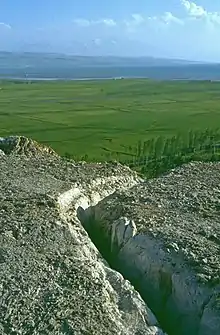Shamiram Canal
The Shamiram canal also known as Semiramis canal previously Menua canal is a canal located east of Van that runs 45 miles long supplying a large region.[1] King Menua built the Semiramis canal, according to his inscriptions, which are still visible by the canal.[2] Menua's canal, which brought fresh water to the capital city of Tushpa, has survived to the present day and is known to the people of the Van region as the "canal of Semiramis,".[3]

History
The construction of the canal according to an Urartian inscription was written:
By the will of Khaldi, Menua, son of Ishpuini, has built this canal. This canal is named Menua Canal. Menua the powerful, the great king, King of Biaina, Prince of the city of Tushpa; Menua speaks in the name of the dread Khaldi: Whosoever damages this inscription , whosoever overturns it, whosoever does such things according to his own desire or in the name of another, Menua warns that the dread god Khaldi, the god Teisheba and the Sun god Sivini will efface him from the sign of the sun.[4]
Banister Fletcher wrote,
The Shamiram Su (Semiramis Canal) is the most famous of the canals and cisterns which formed a major part of the works of the successive Urartian kings, and was constructed by Menua to bring water from the valley of the Hosap river south-east of Van to the fields and gardens round the capital. This canal is largely visible to this day.[5]
References
- East and west , Volumes 12-13. Instituto italiano per il Medio ed Estremo Oriente, Rome. p. 189.
- Gruen, Erich S. Cultural Borrowings and Ethnic Appropriations in Antiquity. p. 13.
- Azarpay, Guitty. Urartian art and artifacts: a chronological study. p. 10.
- Chahin, M. The Kingdom of Armenia: A History. p. 74.
- Banister Fletcher, Sir. Sir Banister Fletcher's A history of architecture. p. 77.
